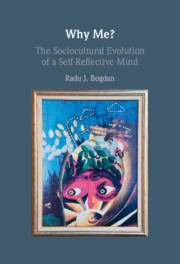Book contents
- Why Me?
- Why Me?
- Copyright page
- Dedication
- Epigraph
- Contents
- Acknowledgments
- Introduction
- 1 Framing the Issue
- Part I The Architecture
- Part II The Evolution
- 4 An Evolutionary Paradigm
- 5 Reasons for Self-Reflection
- 6 Scaffolding Self-Reflection
- 7 A Public Sense of Me
- 8 Questions and Answers
- Glossary
- References
- Index
5 - Reasons for Self-Reflection
from Part II - The Evolution
Published online by Cambridge University Press: 28 May 2021
- Why Me?
- Why Me?
- Copyright page
- Dedication
- Epigraph
- Contents
- Acknowledgments
- Introduction
- 1 Framing the Issue
- Part I The Architecture
- Part II The Evolution
- 4 An Evolutionary Paradigm
- 5 Reasons for Self-Reflection
- 6 Scaffolding Self-Reflection
- 7 A Public Sense of Me
- 8 Questions and Answers
- Glossary
- References
- Index
Summary
Looking for why the competence for self-reflection evolved in human minds, one may wonder whether those reasons, qua selection pressures, can be found among those that also explain the evolution of the mental capabilities running several practices that are widely credited to have made the human difference – most notably, tool making and use, an intense sociopolitics, cultural creation and transmission, and of course language learning and use. Section 5.1 reviews this evolutionary avenue but does not find it promising. Section 5.2 returns briefly to memory for clues about the kinds of environments that may have stimulated the evolution of autobiographical memory as a platform for self-reflection. Section 5.3 finds confirmation of those clues in the competitive and dynamic sociopolitical and cultural environments, and their challenges, that children encounter and to which they must adapt after the age of four. Children’s adaptation to these new environments depend on how they regulate their mental and behavioral responses, according to section 5.4.
- Type
- Chapter
- Information
- Why Me?The Sociocultural Evolution of a Self-Reflective Mind, pp. 95 - 112Publisher: Cambridge University PressPrint publication year: 2021

